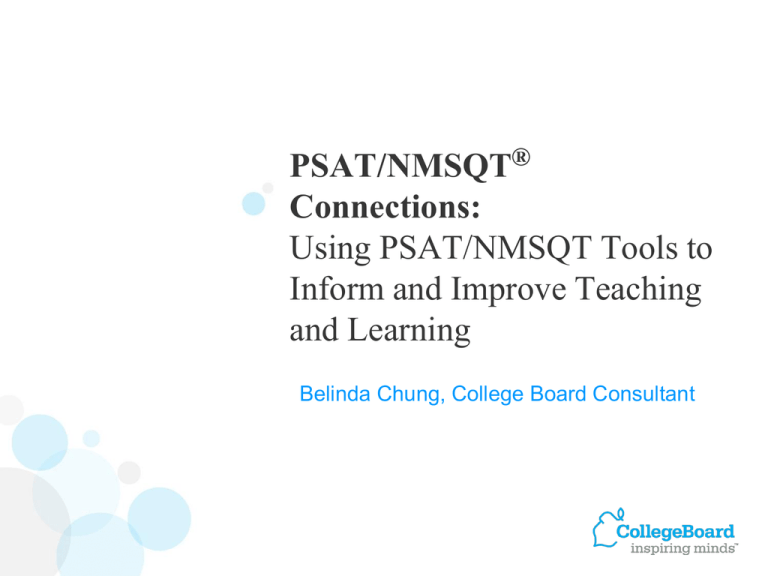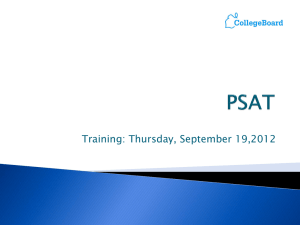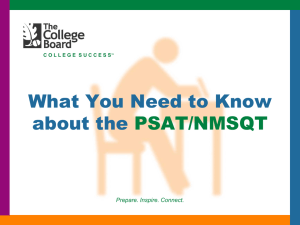PSAT SOAS Report Workshop Power Point
advertisement

PSAT/NMSQT® Connections: Using PSAT/NMSQT Tools to Inform and Improve Teaching and Learning Belinda Chung, College Board Consultant Today’s agenda January 15, 2011 • • PSAT/NMSQT Overview PSAT/NMSQT Score Report Plus • AP Potential • Sample Questions Work • SOAS Report Overview • SOAS Group Work • Group Insights/Recommendations & Action Plan • Evaluation Mission The College Board's mission is to connect students to college success and opportunity. We are a not-for-profit membership organization committed to excellence and equity in education. PSAT/NMSQT Overview PSAT/NMSQT Overview Content and Question Types • Performance compared to the state and nation • Question-by-question analysis • Early wake-up call • • 3.57 million students (2010) • 55.5% of test takers are pre-juniors (2010) Utilize tools to help you when Understanding by Design (backwards planning) What is the PSAT/NMSQT? • A comprehensive academic reasoning test, which focuses on skills that all students need to succeed in high school and college. • These reasoning skills focus on the three main academic areas, but their attainment affects all areas of learning, as they are transferable process skills that are needed to manage and apply knowledge, regardless of content orientation. • These skills are relevant to all students, and are needed by all students, thus the strong focus on inclusion when testing with the PSAT/NMSQT. PSAT/NMSQT Overview • The PSAT/NMSQT is a school-based test • Comprised of five sections: • 2 Critical Reading • 2 Mathematics • 1 Writing Skills • Critical Reading, Mathematics and Writing Skills scores are on a 20-80 scale PSAT/NMSQT Overview Content and Question Types Critical Reading Two 25-minute sections 48 questions total : - 13 sentence completion - 35 passage based reading 50 mins Mathematics Two 25-minute sections 38 questions total: - 28 multiple choice - 10 student produced response 50 mins Writing Skills One 30-minute section 39 questions total: - 20 improving sentences - 14 identifying sentence errors - 5 improving paragraphs 30 mins PSAT/NMSQT Overview Content and Question Types • • • Performance compared to the state and nation Question-by-question analysis Early wake-up call • 3.57 million students (2010) • 55.5% of test takers are pre-juniors (2010) • Utilize tools to help you when Understanding by Design (backwards planning) Average Test Scores For Juniors Average Test Scores For Sophomores Critical Reading Overview PSAT/NMSQT Overview Critical Reading Questions focus on: Student’s ability to read critically Student’s ability to think logically Student’s ability to analyze Student’s ability to evaluate PSAT/NMSQT Overview Critical Reading Critical Reading Two 25-minute sections 48 questions total - 13 sentence completion - 35 passage based reading 5 skills • Determining the Meaning of Words • Author’s Craft • Reasoning and Inference • Organization and Ideas • Understanding Literary Elements 50 mins PSAT/NMSQT Overview Sentence Completion 5. Because their behavior was ------- , Frank and Susan served as ------- models for the children under their excellent care. (A) incorruptible . . pernicious (B) lamentable . . flawed (C) commendable . . exemplary (D) erratic . . unimpeachable (E) reputable . . imperfect PSAT/NMSQT Overview Sentence Completion 5. Because their behavior was ------- , Frank and Susan served as ------- models for the children under their excellent care. (A) incorruptible . . pernicious (B) lamentable . . flawed (C) commendable . . exemplary (D) erratic . . unimpeachable (E) reputable . . imperfect Difficulty Level = Easy Skill = Determining the Meaning of Words PSAT/NMSQT Overview Critical Reading Sample Skill Determining the Meaning of Words Use vocabulary skills, context, roots, prefixes, and suffixes to determine the meaning of words. PSAT/NMSQT Overview Passage Based Reading Passage: Line1 Advertisers are interested in finding out what exactly makes pop-up ads on the Internet irritating to viewers. Why are these ads seen as intrusive? One 2002 marketing study determined that when Internet users are focused, Line 5 they perceive interruptions as more severe than when they are not focused. What seems to get the attention of viewers (rather than merely annoy them) is to expose them to popup ads only at breaks in content—for example, when they are switching between pages. Another marketing strategy Line 10 is to increase the relevance of the ad. If a consumer is browsing an automobile Web site, a pop-up ad for a car will seem less intrusive than will a travel ad. PSAT/NMSQT Overview Passage Based Reading 9. The primary function of the sentence in lines 3-6 (“One . . . not focused”) is to (A) paraphrase the question posed in line 3 (B) present a relevant research finding (C) hypothesize about a solution to a problem (D) shift the focus to a different medium (E) address a concern of Internet users PSAT/NMSQT Overview Passage Based Reading 9. The primary function of the sentence in lines 3-6 (“One . . . not focused”) is to (A) paraphrase the question posed in line 3 (B) present a relevant research finding (C) hypothesize about a solution to a problem (D) shift the focus to a different medium (E) address a concern of Internet users Difficulty Level = Medium Skill = Organization and Ideas PSAT/NMSQT Overview Critical Reading Sample Skill Organization & Ideas Understand the organization of a reading passage, and identify the main and supporting ideas. Mathematics Overview PSAT/NMSQT Overview Mathematics The primary aim of the math section is to assess how well students understand and reason within a math framework: Can they apply what they already know to new situations, i.e. transfer their learning and knowledge? Can they reason and problem-solve within a high school math context? PSAT/NMSQT Overview Mathematics Mathematics Two 25-minute sections 38 questions total 50 mins - 28 multiple choice - 10 student produced response 4 Content Skills 5 Process Skills • Number and Operations • Problem Solving • Algebra and Functions • Representation • Geometry & Measurement • Reasoning • Data, Statistics, & Probability • Connections • Communication PSAT/NMSQT Overview Mathematics Question 30 (Student–Produced Response) Each year from January 1 through January 8, the number of daily customers c at a music store is estimated by c =1200 + 2x, where x is the day of the month. How many more customers are estimated to be at the music store on January 5 than on January 1? PSAT/NMSQT Overview Mathematics Question 30 (Student–Produced Response) Each year from January 1 through January 8, the number of daily customers c at a music store is estimated by c =1200 + 2x, where x is the day of the month. How many more customers are estimated to be at the music store on January 5 than on January 1? The correct answer is 30. For January 1, the day of the month, x, is equal to 1, and so the estimated number of customers on January 1 is c = 1200 +21 = 1202. For January 5, the day of the month, x, is equal to 5, and so the estimated number of customers on January 5 is c =1200 +25 = 1232. Therefore, there are estimated to be 1232–1202 = 30 more customers at the music store on January 5 than on January 1. Level of Difficulty = (M) Skill(s) = Algebra and Functions Problem Solving PSAT/NMSQT Overview Student-Produced Response Algebra and Functions Solve problems using algebraic expressions and symbols to represent relationships, patterns and functions of different types. Problem Solving Solve abstract and practical problems, applying and adapting a variety of strategies. Monitor progress and evaluate answers in terms of questions asked. Writing Skills Overview PSAT/NMSQT Overview Writing Skills Writing Skills questions test students’ ability to edit written work and find the most effective means to communicate a thought. PSAT/NMSQT Overview Writing Skills Writing Skills One 30-minute section 39 questions total: - 20 improving sentences - 14 identifying sentence errors - 5 improving paragraphs 30 mins 5 Skills • Manage Word Choice and Grammatical Relationships between Words • Manage Grammatical Structures Used to Modify or Compare • Manage Phrases and Clauses in a Sentence • Recognize Correctly Formed Sentences • Manage Order and Relationships of Sentences and Paragraphs PSAT/NMSQT Overview Identifying Sentence Errors Understanding the difference between criticism A and insult enhances one’s ability to engage in B C D constructive argument. No error E PSAT/NMSQT Overview Identifying Sentence Errors Understanding the difference between criticism A and insult enhances one’s ability to engage in B C D constructive argument. No error E Level of Difficulty = (E) Skill = Correctly formed sentences PSAT/NMSQT Overview Identifying Sentence Errors Correctly Formed Sentences Recognize correct sentence structure. Student Feedback: Paper Score Report Plus & My College QuickStart Score Report Plus • Scores and percentiles Personalized feedback on skills • • Student answers • Next Steps My College QuickStart™ Signing in Students use the access code on their PSAT/NMSQT® paper score report to sign in at www.collegeboard.com/quickstart. My Online Score Report Look Beyond Scores • Performance on each skill measured • State and national percentiles • Projected SAT® score ranges My Online Score Report Your Answers • Questions and answer explanations • Students can filter questions My SAT Study Plan Prepare for the SAT® • Personalized skills to improve • SAT practice questions • An official SAT practice test My SAT Study Plan Review and Practice • Review PSAT/NMSQT® questions missed • Answer SAT ® practice questions of the same type My SAT Study Plan My Skills Feedback • Based on PSAT/NMSQT results • Hundreds of practice questions, organized by skill My SAT Study Plan Warm Up for the SAT® Essay • Strategies for success • Official scoring guide • Practice essay questions • Sample essays for the each score 1-6 Express SAT® Sign-Up My Personality My Personality My Personality My Major & Career Matches Connect to the Possibilities • Major a student chose • Related majors • Related careers My Major & Career Matches Research Majors • Description of majors • Courses students should take in high school to prepare • Courses they will take in college • Jobs students can expect achieving different degree levels My College Matches Start the College Search • Starter list of colleges • Criteria to customize search • Ability to save searches My College Matches Get the Facts • Admissions • Cost and financial aid • Majors offered • Sports, housing and more My College QuickStart Tips Arrange for a computer lab session to introduce students to My College QuickStart Use free lesson plans to guide students through structured activities Check out the demo for educators http://professionals.collegeboard.com/k-12/prepare/quickstart AP Potential What is AP Potential? • A web-based tool • Free for schools that administer the PSAT/NMSQT ® • Provided by the maker of the AP ® Exams • Designed to ensure that no student is overlooked • Based on proven research AP Potential •Identifies “diamond-in-the-rough” students •Promotes equity Helps identify students who initially might have been overlooked for AP courses •Is a useful tool for principals, teachers, and counselors to Expand AP programs Increase enrollment in current AP courses The PSAT/NMSQT and AP Connection Research shows a strong relationship between PSAT/NMSQT and AP • Studies conducted in 1998 and 2006 • Analyzed performance of more than a million students • Showed strong correlations between PSAT/NMSQT® scores and AP® Exam results • Download the research reports at www.collegeboard.com/appotential Traditional Methods of Identifying Students for AP Courses •Teacher recommendations •Self-nomination •History of courses completed •Student grades •Student discussion Access to AP is Important •AP access is linked to success in college. Rigorous high school curriculum is key •Participation in AP is linked to college completion. It is a stronger indicator than socioeconomic status and GPA. Signing in to AP Potential™ : www.collegeboard.com/appotential Signing in to AP Potential www.collegeboard.com/appotential AP Potential Expectancy Tables Expectancy Tables See data from the correlation study showing the percentage of students at any given PSAT/NMSQT score range. AP Potential Select PSAT/NMSQT® Administration Year Step 1 of 4 • Select the PSAT/NMSQT ® administration year for which you’d like to generate a roster. AP Potential Select Subjects Step 2 of 4 • Select the AP subject areas your school offers. AP Potential Select Pool Step 3 of 4 • Choose a grade level and define your pool. AP Potential Student Roster Step 4 of 4 Read the instructions for using the roster and see your list of students at the bottom of the screen. • AP Potential Subject Detail • Student names • Correlations and Student scores • Ethnicity • Gender AP Potential Student Detail • All courses selected noted • Status of meeting the criteria • Probability for scoring a 3 noted AP Potential Tips Export data into an Excel spreadsheet to make it easy to read and use. Create letters to parents. AP Potential™ provides sample letters in English and Spanish. AP Potential Tips •After considering potential AP students using your school’s standard process, check AP Potential for additional students that might have been overlooked. •Use AP Potential to make a case for professional development - more teachers will need to be trained to handle an increased number of AP courses. AP Potential for 9th and 10th graders in preparation for 11th or 12th grade AP courses and ensure that they are taking the correct preparatory courses •Review Activity A: Getting to know the Test SOAS Introduction Audience • Administrators • Department heads • Curriculum specialists • Teachers • Other staff interested in students’ college preparatory skills Note: the more inclusive the testing within each grade, the more meaningful and applicable the results. Instructions: Part I, Solo Activity (20 minutes) Activity A • Review the PSAT/NMSQT skills list in your binder in order to become familiar with the skills for your academic area. • You will have 20 minutes to take sample PSAT/NMSQT • Mark your answers in the exam booklet • Immediately after answering a question, refer to the List of Academic Skills list and, in the test book next to the question number, identify the skill group(s) that you feel is needed to answer the question. Instructions: Group Activity (20 minutes) Activity A • Gather in groups by subject matter (no more than 7 per group). Each group needs a Leader and a Recorder. • You will have 20 minutes to review at least 5 questions from the test-taking activity, to compare notes on the skills needed to the answer questions: • • English teachers, do at least 3 Critical Reading questions and 2 Writing Skills questions • Math teachers, do at least 3 multiple choice questions and 2 SPR questions Take 15 -20 minutes to answer the following questions: Discussion Topics: Activity A 1. How would the content covered in these questions be familiar to your 10th grade students? 11th grade students? 2. How are these test questions similar to question types you would present in class? 3. Was there agreement in the group on the skills coding? If no, what kinds of issues caused disagreement? 4. How do these skills compare to the skills you would expect your students to have? (10th? 11th?) 5. How did the “group’s” coding match the test developer’s coding? The Summary of Answers and Skills (SOAS) Logging In Repeat Users www.collegeboard.com/results Logging In New Users If it’s your first time, you’ll need your school’s SOAS access code Supporting Materials SOAS Resources Your Reports Report Orientation Table of Contents Page(s) • Title Page • Performance Overview 1 • Skills Analysis 2, 6-7, 11 • Question Analysis 3-4, 8-9, 12-13 • Comparable Group Analysis 5, 10, 14 Performance Overview Page 1 • Number of students in report • Mean scores and • score distribution • College Readiness Benchmarks Skills Analysis Pages: 2, 6-7, 11 • Skills • Triangles show a comparison to the state and nation • Each test question is linked to a skill Question Analysis Pages: 3-4, 8-9, 12-13 • Student responses and answer patterns • Comparisons to the state and nation Question Analysis Tips: Look for questions your Students answered incorrectly that the students in the state and nation answered correctly Look for commonly Wrong answers Comparable Group Analysis Pages: 5, 10, 14 SOAS Comparable Group What is a comparable group? • A useful statistical model • A statistically created group (virtual group) • Mirrors your group’s performance profile • This creates an expected performance indicator for your group on each question. • Provides more “actionable” feedback than state or national averages on questions/skills. Comparable Group Analysis Pages: 5, 10, 14 Darker blue = significantly below the comparable group. Lighter blue = significantly above the comparable group Resources Resources Test Questions and Answer Explanations How does it all add up? 1. Identify 2. Find 3. View a skill the measur questio for eddetails by n review this questio n Other Relevant Resources: Before, During, and After SOAS review Understanding PSAT/NMSQT Scores • PSAT score related FAQ’s • Information on percentiles and mean scores • Score conversions PSAT/NMSQT Summary Reports PSAT/NMSQT Summary Reports Summary Reports are provided to all schools that tested at least 50 juniors or sophomores. State level summary reports are also available (College Bound Juniors/Sophomores reports) www.collegeboard.com/reporting Reports contain: • number of test-takers • ethnic background • participation in Student Search Service • self-reported GPA • performance by score range • college major Activities Activity B Review Skills Analysis Instructions • Work within your own school group/academic area, using your school’s SOAS report. • Identify the skill that your students had the lowest performance on. • Using the Test Question and Answer Explanations, look at each question aligned to that skill. • Things to look for: Skills furthest below the state/national average Skills that are furthest to the left (i.e. those that are the weakest for the group). Skills that came to teachers’ attention after review of Question Analysis. Activity B Review Skills Analysis Questions for Consideration Within your group, answer the following questions: 1. Is there a pattern in the skills you identified as problematic? 2. Are there actions or strategies that might help address the issues? Activity C Review Question Analysis Instructions • Work within your own school group/academic area, using your school’s SOAS report. • Refer to the Test Questions and Answer Explanations to make note of problem questions and how they might be addressed. • Things to look for: Easier questions (difficulty level 1-3) where less than a 2/3 of the students answered correctly. A larger proportion of your students answered incorrectly or omitted an answer in comparison to the state/nation Commonly wrong answers Review any questions that generated teacher interest when you took the test in Activity A. Activity C Review Question Analysis Questions for Consideration Within your group, answer the following questions: 1. Are there any patterns in the questions you identified as problematic? 2. Are there actions or strategies that might help address the issues? 3. Summarize your findings for sharing. Activity D Comparable Group Analysis Instructions • Work within your own school group/academic area, using your school’s SOAS report. • Using the Test Question and Answer Explanations, look at each question. • Things to look for: Questions that fall into the dark blue area, where your students performed below expectation. Questions that fall into the light blue area, where your students performed higher than expectation. Activity D Comparable Group Analysis Questions for Consideration Within your group, answer the following questions: 1. Is there a pattern in the skills aligned with the test questions your students performed below expectation on? 2. Is there a pattern in the skills aligned with the test questions your students performed expectation on? 3. Are there actions or strategies that might help address the issues? For Group Discussion To Help Students and Parents 1. How does the school educate parents about the wealth of information on Score Report Plus? 2. What plan does the school have in place to make sure students receive and understand their scores? For Group Discussion Using Your SOAS Data •Identify the skills associated with the questions students answered incorrectly. •Make inferences about what led to errors. •Identify where in the curriculum the skills are (or are not) taught. •Work with departments and classrooms to review common concerns. •What recommendations can you make to your school for increased student success? Closing Thoughts Using Assessments for School Improvement • Identify skills to help guide instruction and curriculum planning • Connect more students with challenging high school courses and college attendance • Increase Advanced Placement Program courses in your school system; more professional development for teachers • Close the achievement gap in your community The Excellence and Equity Challenge “Without preparation, opportunity is an empty promise.” Alan Page, former NFL star, current Minnesota State Supreme Court Justice Austin American Statesman, 10.25.02 Looking Ahead: 2011 PSAT/NMSQT Wednesday, October 12th Saturday, October 15th






